#Elizabeth Sherrill
Explore tagged Tumblr posts
Text

Careful What You Wish For: Directed by Elizabeth Allen Rosenbaum. With Nick Jonas, Kiki Harris, David Sherrill, Graham Rogers. A guy gets more than he bargained for after entering into an affair with the wife of an investment banker. Soon, a suspicious death and substantial life insurance policy embroil him in a scandal.
0 notes
Text
Died: ‘The Hiding Place’ and ‘The Cross and the Switchblade’ Coauthor Elizabeth Sherrill
http://dlvr.it/SqJRwP
0 notes
Text
Publisher and Author Elizabeth Sherrill Dead at 95
BookJubilee.Com http://dlvr.it/Sq340j
0 notes
Text
F.F. Bosworth featured in Dean Merrill’s book, ‘50 Pentecostal and Charismatic Leaders Every Christian Should Know’

F.F. Bosworth is one of many Pentecostal leaders featured in Dean Merrill’s book, “50 Pentecostal and Charismatic Leaders Every Christian Should Know” (Chosen Books, 2021). The book, which is similar to Lester Sumrall’s “Pioneers of Faith” (Harrison House, 1995), is a collection of profiles that provides a brief overview of Pentecostal and charismatic leaders who played important roles in revival movements and church history. As for Bosworth, Merrill describes him as “a man who wanted to hear from God equally as much as to speak for God and be the conduit of His healing power.”
The book features a long list of names that are well known. In addition to Bosworth, the list includes such luminaries as Maria Woodworth-Etter, Smith Wigglesworth, Charles Mason, William J. Seymour, John G. Lake, Aimee Semple McPherson, Donald Gee, Agnes Sanford, David du Plessis, Gordon and Freda Lindsay, Wonsuk and July Ma, Dennis and Rita Bennett, John and Elizabeth Sherrill, Francis and Judith MacNutt, Jack Hayford, Oral Roberts, William Branham, Harald Bredesen, Jane Hansen Hoyt, and John Wimber.
Dr. Craig S. Keener, who wrote the Foreword, describes the book as “a handy primer on most of the leading figures --- a valuable refresher for those schooled in Pentecostalism and a crucial survey to initiate beginners.” As such, the book is sure to answer questions, fill in gaps, inspire, and perhaps invigorate a new generation in the study of Pentecostal church history.
As the author, Merrill continues to add to an already impressive career. He is the former editor of Campus Life and Leadership Journal. He also served as editorial director for David C. Cook and Focus on the Family. He has written 10 books and co-authored 39 others, according to his bio. Some of his titles have been ranked on New York Times bestseller lists.
Note: John Lathrop wrote an excellent review of this book for The Pneuma Review. It can be read here.
Key moments in Bosworth’s life
Merrill’s 282-page volume gives readers a quick overview of the key moments in Bosworth’s life history. He opens the chapter with Bosworth’s dilemma in Lima, Ohio. Bosworth had been asked to preach on the subject of divine healing. He believed in healing, but he wrestled with the fact that all were not healed in answer to prayer. After some reflection and prayer, he concluded it was his job to preach and pray for the sick, and to leave the results to God. He’d asked, “Lord, suppose I preach on healing, and the people come and don’t get healed?” The Lord reportedly replied, “If people didn’t get saved, you wouldn’t stop preaching the Gospel.” From that point, Bosworth began preaching the message of salvation and healing with unrelenting boldness.
Merrill follows this section with two widely known cases of healing in Bosworth’s ministry. The first case is about the school for the deaf in Chicago in the 1920s where multiple students were reportedly healed through Bosworth’s ministry. David J. du Plessis mentioned the healings in the April 1958 issue of World-Wide Revival. He wrote:
See the full article here: https://ffbosworth.mystrikingly.com/blog/f-f-bosworth-featured-in-dean-merrill-s-book-50-pentecostal-and
0 notes
Text
The God Even of Ravensbruck: The Hiding Place
The God Even of Ravensbruck: The Hiding Place
The Hiding Place (1971) by Corrie ten Boom with John and Elizabeth Sherrill “I know that the experiences of our lives, when we let God use them, become the mysterious and perfect preparation for the work He will give us to do.” (Corrie ten Boom) “If people can be taught to hate, they can be taught to love. We must find the way, you and I, no matter how long it takes…” (Betsie ten Boom) At my…

View On WordPress
0 notes
Photo

“Vegas Vicki,” Pioneer Club hostess and rep (Edna Sherrill) at Craig Road racetrack c. 1967. Photo by MJ "Bo" Boisvert, thanks to Brent Boisvert.
The hostess character was performed by least three different woman over the ten years of the role including Jody Powers, Elizabeth Ann Wohlfeil, and Sherrill in the late 60s.
231 notes
·
View notes
Photo

16 Inspiring Memoirs That Will Change the Way You See the World
[via BookBub Blog]
Tuesdays with Morrie by Mitch Albom
Somebody’s Daughter by Ashley C. Ford
Eat Pray Love by Elizabeth Gilbert
When Breath Becomes Air by Paul Kalanithi
Forever Young by Hayley Mills
Angela’s Ashes by Frank McCourt
Born a Crime by Trevor Noah
Becoming by Michelle Obama
In Order To Live by Yeonmi Park
Just Mercy by Bryan Stevenson
The Hiding Place by Corrie ten Boom, Elizabeth Sherrill, and John Sherrill
The Glass Castle by Jeannette Walls
Educated by Tara Westover
Night by Elie Wiesel
I Am Malala by Malala Yousafzai
Believing by Anita Hill
...
Click through to see more titles.
13 notes
·
View notes
Text
OK, September 7
Cover Story -- Cher’s dream wedding at 74

Page 1: Big Pic -- Katy Perry got dolled up in an array of funky ensembles to promote her song What Makes a Woman
Page 2: Contents

Page 3: Contents

Page 4: Melissa McCarthy thriving at 50 -- after her milestone birthday Melissa’s opening up about how she overcame hardships to come out on top
Page 5: For years Prince William and wife Duchess Kate Middleton have watched from the sidelines as Prince Harry and Meghan Markle have dominated headlines but the couple are finally ready to tell their side of the story in a sit-down TV interview -- it won’t be a scandalous interview but it will certainly right a few wrongs and misconceptions
Page 6: As Drew Barrymore gears up for her talk show premiere she’s counting on her famous friends to bring in more viewers, as Kim Kardashian and Kanye West struggle to keep their marriage afloat Caitlyn Jenner has been sending them well-wishes but Kim would rather Caitlyn just keep her lips zipped -- Kim’s told everyone to keep their opinions to themselves while she works through this crisis one-on-one with Kanye but Cait’s been sounding off and telling anyone who’ll listen how she believes he’s gotten a raw deal, Chrishell Stause is out to destroy ex Justin Hartley’s reputation and his new romance with Sofia Pernas -- Chrishell is bitter and is calling out Justin as a liar and a cheater and telling friends that his new girlfriend should be careful
Page 10: Red Hot on the Red Carpet -- stars sparkle in champagne hues -- Elizabeth Chambers, Angela Bassett, Kim Kardashian West
Page 11: Jennifer Lopez, Scarlett Johansson
Page 12: Who Wore It Better? Thandie Newton vs. Georgia May Jagger
Page 16 -- News in Photos -- Cara Santana celebrated her birthday on the beach in Malibu
Page 18: Rita Ora vacationing in Corfu in Greece, Dwayne “The Rock” Johnson and his daughters Jasmine and Tiana, Pete Wentz plays tennis
Page 20: Nick Barrotta got in a workout while shooting scenes for The Oval, Ireland Baldwin spent the day at the beach with her uncle Stephen Baldwin
Page 21: Sofia Richie paddleboarding, Alessandra Ambrosio playing volleyball, Gavin Rossdale takes a shirtless stroll on the beach
Page 23: RHOBH star Brandi Glanville helping wash a friend’s car, Adam Sandler shooting hoops on the street
Page 24: Inside My Home -- Brittany Snow’s selling her home in Studio City for $2.7 million
Page 26: The Property Brothers double baby joy -- Drew Scott and his wife Linda Phan are finally expecting and his twin Jonathan Scott’s girlfriend Zooey Deschanel is also pregnant
Page 27: Ben Affleck is being kept on a tight leash by girlfriend Ana de Armas as she wants to know where Ben goes and who he’s with at all times and she gave him a 9 p.m. sharp curfew, Rachael Ray and husband John Cusimano have found a silver lining in the wake of their devastating house fire as it made them appreciate what really matters most is each other so for their 15th anniversary they’re going to renew their vows with a few added words inspired by what they’ve learned in the aftermath of this tragedy, Bindi Irwin and husband Chandler Powell already have themselves a cash cow in their unborn child because the demand for an interview with Bindi and Chandler about their pregnancy news is huge right now and they’ve learned from her mom Terri Irwin that cashing in at the right time is key plus they could really use some extra money right now since the family business Australia Zoo isn’t doing so well
Page 28: Ever since Melanie Griffith got word that ex Antonio Banderas had tested positive for Covid-19 she has made it her mission to help nurse him back to health by calling at all hours and texting him with tons of advice to keep his strength up and although Antonio appreciates her acts of kindness his girlfriend Nicole Kimpel feels the two are getting too close for comfort especially since she’s been at his side throughout the ordeal, while the rest of the world is in chaos Cameron Diaz and Benji Madden are keeping cool calm and collected as they dote on daughter Raddix and Cameron is looking for answers about how to raise a child in these crazy times and she’s found crystals and psychics to be so helpful, Love Bites -- Chrissy Teigen and John Legend are expecting baby no. 3, Miley Cyrus and Cody Simpson split, Jesse Metcalfe and Corin Jamie Lee Clark are dating
Page 29: Meg Ryan and John Mellencamp ended their on-off romance last October and John moved on with Jamie Sherrill but lately Meg has been blowing up John’s phone and he’s happily answering -- Meg’s recent move to Montecito in California brought her closer to John who’s been in L.A. a lot more since that’s where Jamie’s skincare business is -- John thinks Jamie is a lovely lady but he and Meg are soulmates and it’s a matter of when not if they’ll get back together
Page 30: Cover Story -- Cher is getting married -- the legendary star is set to stay I Do to her 27-year-old rocker beau
Page 34: Lifestyles of the Young and Famous -- the plush and pampered lives of billion-dollar celebrity kids -- North West, Emme Muniz
Page 35: Blue Ivy Carter, Harper Beckham, Princess Charlotte
Page 36: Louis Bullock, Penelope Disick, Shiloh Jolie-Pitt
Page 37: Moroccan and Monroe Cannon, Apple Martin, Mom Knows Best -- a few of the best mommas in Hollywood -- Jennifer Garner, Reese Witherspoon, Gwen Stefani
Page 38: Interview -- Selena Gomez dishes it out
Page 40: How Cindy Crawford stays in tip-top shape
Page 41: Like Mother, Like Daughter -- Kaia Gerber is a chip off the old block in the health and wellness department
Page 44: Style Week -- Megan Thee Stallion is Revlon’s new face
Page 46: Run errands in style with a superchic totally sleek tiny phone purse -- Zoey Deutch
Page 47: 5 minutes with Tiffani Thiessen
Page 48: Fashion -- the classic post earring gets a bold and stylish upgrade -- Margot Robbie
Page 50: Beauty -- beauty booty from around the world
Page 52: Entertainment
Page 53: Fall TV preview, Q&A with Mister E
Page 58: Buzz -- in living color -- these stars recently transformed their dresses -- Jesse Williams goes blue, Lady Gaga in green called Ocean Blonde, Jim Parsons goes blond
Page 59: Emily Ratajkowski goes blonde, Sarah Hyland goes red, Faith Hill goes pink, Joe Jonas goes platinum, Ariel Winter goes blonde, Gigi Hadid goes darker, Kaia Gerber goes pink
Page 60: Sound Bites -- Olivia Colman on portraying Queen Elizabeth II on The Crown, Andy Cohen on which Real Housewives he’d trust to babysit his son Ben, Angelina Jolie on quarantining with her six kids, Luke Bryan roasting pal Blake Shelton
Page 61: Adele responding to a fan who asked when she’d be releasing her next album, Jennifer Aniston on playing a celebrity news anchor on The Morning Show, David Arquette on teaming up with ex Courteney Cox for Scream 5, Kelly Ripa to daughter Lola on her habit of stealing her mom’s crop tops
Page 62: Horoscope -- Virgo Zendaya turned 24 on September 1
Page 64: By the Numbers -- Olivia Culpo
#tabloid#grain of salt#tabloid toc#tabloidtoc#cher#prince william#duchess kate#kate middleton#william and kate#will and kate#prince harry#meghan markle#queen elizabeth#Cindy Crawford#kaia gerber#olivia culpo#melissa mccarthy#drew barrymore#kim kardashian#kanye west#caitlyn jenner#chrishell stause#justin hartley#who wore it better?#brittany snow#drew scott#linda phan#jonathan scott#zooey deschanel#ben affleck
8 notes
·
View notes
Text
One of Our Time's Most Spiritually Impactful Authors Dies
One of Our Time’s Most Spiritually Impactful Authors Dies
by Steve Eastman, Wait Til You Hear This
Christianity Today has called John Sherrill and his wife “the most influential Christian authors you know nothing about.” But their books captured the imagination of people in the 1960s and beyond, contributing greatly to a spiritual awakening when the world was otherwise wondering if God was dead.
[youtube=http://www.youtube.com/watch?v=BDBDkqBP8NU&w=740&h…
View On WordPress
#70th anniversary#Book of Acts style revival#Brothr Andrew#Corrie ten Boom#David Wilkerson#Elizabeth Sherrill#God&039;s Smuggler#John Sherrill#Nazi concentration camp#Nicky Cruz#Pat Boone#spiritual awakeniing#The Cross and the Switchblade#The Hiding Place#They Speak with Other Tongues. Guideposts
0 notes
Text
Dec. 4, 2019: Obituaries
Debra Bauguess, 65

Debra Lou Bauguess, age 65, of North Wilkesboro, passed away Sunday, December 1, 2019 at Wake Forest Baptist Health-Wilkes Regional. Debra was born December 19, 1953 in Wilkes County. She was preceded in death by her father, Clint Call; mother, Evelyn Sparks Lyall; brother, Randall Call; and sister, Mary Acosta.
Surviving are her husband, Mark Bauguess; daughter, Tina Bauguess Durham and spouse Brock of Roaring River; son, Michael Bauguess of North Wilkesboro; grandchildren, Gralan Durham, Hayden Durham, Allie Brooke Durham; several nieces and nephews.
Graveside service was December 3 at North Wilkesboro City Cemetery with Rev. Victor Church officiating. The family has requested no flowers. Memorials may be made to the American Stroke Foundation, 6405 Metcalf Avenue, Suite 214, Overland Park, Kansas 66202. Miller Funeral Service is in charge of the arrangements.
Shelba Church, 82

Shelba Jean Church, age 82, of Wilkesboro, passed away Sunday, December 1, 2019 at Forsyth Medical Center. She was born February 20, 1937 in Wilkes County to Cecil Lee and Mildred Marie Whittington Church.
Mrs. Church was a member of Lewis Fork Baptist Church. She was preceded in death by her parents; brothers, Rex Lee Church and Cecil Ralph Church.
Surviving are her husband, Loyde Church; son, Tim Church and spouse Courtney of Wilkesboro; grandchildren, Madalyn Church and Alexis Church; brother, Kenneth Reece Church and spouse Sheila.
Service was December 3, 2019 at Lewis Fork Baptist Church with Pastor Dwayne Andrews and Rev. Sherrill Wellborn officiating. Burial followed in the Church Cemetery. Flowers will be accepted. The family has requested no food, please. Miller Funeral Service is in charge of the arrangements.
Randall Wagoner, 49
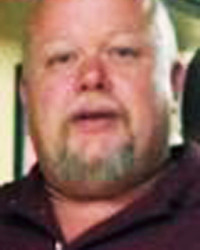
Mr. Randall Shannon Wagoner, 49, of Wilkesboro, passed away on Thursday, November 28, 2019.
Randall was born on Wednesday, March 18, 1970 in Wilkes County to Linda Mae Wagoner.
Randall is preceded in death by his brother Rex Allen Parsons and step father Rex Elisha Parsons.
Randall is survived by his wife, Kimberly Porter Wagoner of the home; daughters, Kaitlyn Nicole Wagoner of North Wilkesboro, Erica Hannah Wagoner of Wilkesboro; mother Linda W. Brown and Christopher "Chris" Brown of North Wilkesboro.
A graveside service was held December 1, at Pleasant Grove Baptist Church Cemetery with Rev. Brady Hayworth and Preacher Scott Wagoner officiated..
In lieu of flowers memorial donations may be given to the Pleasant Grove Baptist Church Cemetery Fund.
Adams Funeral Home of Wilkes has the honor of serving the Wagoner Family.
Margaret Call, 76

Mrs. Margaret Elizabeth Shepard Call, "Doll" passed away Tuesday, November 26, 2019 at Wilkes Senior Village.
Funeral services were November 30, at Fishing Creek Arbor Baptist Church with Rev. David Welborn and Rev. Allen Bouchelle officiating. Burial was in the church cemetery.
Mrs. Call was born January 2, 1933 in Wilkes County to Clarence and Ermma Staley Shepard. She was retired from American Drew Dining Room Plant. Mrs. Call was a member of Fishing Creek Arbor Baptist Church. Doll as she was called, was a hard worker. She always had an open door for friends, family and her neighbors. She was an excellent caretaker for family and friends, loved to sew, cut hair and especially loved her grandchildren and was a Jack of all trades.
In addition to her parents, she was preceded in death by her husband; James Phillip Call three sisters; Beatrice Williams, Mary Curry and Betty Minton, two brothers; Mack Shepard and Joe Shepard and two grandchildren; Barney Call and Emily Call.
She is survived by a daughter; Peggy Byers and Robert Foster of North Wilkesboro, four sons; Rex Allen Call and wife Nancy of Wilkesboro, Charles Call and Michelle Stanley of Wilkesboro, Randy Call and wife Shirlene of Wilkesboro and Terry Call and Regina Dowell of Wilkesboro, nine grandchildren; Tabitha, Jason, Angie, Anthony, Zach, Dusty, Jamie, Amy and Amanda, sixteen great grandchildren and a brother; David Shepard of North Wilkesboro.
Flowers will be accepted or memorials may be made at Fishing Creek Abor Baptist Church Building Fund 2446 Fishing Creek Arbor Road Wilkesboro, NC 28697 of Alzheimer's Association 4600 Park Road Suite 250 Charlotte, NC 28209.
Nadine Anderson, 86
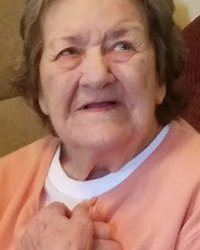
Ms. Nadine Opal Anderson, age 86 of North Wilkesboro, passed away Tuesday, November 26, 2019 at Gordon Hospice in Statesville.
The family received friends November 29, at Reins Sturdivant Funeral Home.
Ms. Anderson was born December 1, 1932 in Wilkes County to James Cicero and Drusey Soots Anderson. She retired from Carolina Mirror. Ms. Anderson loved to cook, bake and read. She loved to read her Bible and loved her family. Nadine was crowned the Farmer's Queen and Miss Wilkes County of 1951.
In addition to her parents, she was preceded in death by a son; Scott Tevepaugh, two sisters and four brothers.
She is survived by seven daughters; Vernell Powers and husband Gary of Moravian Falls, Bobbie Glass of Moravian Falls, Phyllis Spicer and husband Barry of Yadkinville, Terri Guion and husband Bobby of Taylorsville, Julie Tevepaugh of North Wilkesboro, Brenda Tevepaugh of Wilkesboro and Beth Pennell and husband Jody of Stony Point and a son; Robert C. Tevepaugh of North Wilkesboro, eleven grandchildren; twenty one great grandchildren three great great grandchildren and two step grandchildren .
Flowers will be accepted or memorials may be made to Gordon Hospice Home 2341 Simonton Road Statesville NC 28625 or Alzheimer's Association 4600 Park Road Suite 250 Charlotte, NC 28209.
Stella Couplin, 70
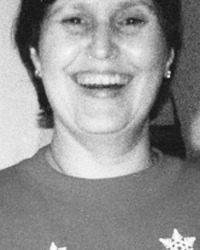
Stella Colleen Couplin, age 70, of North Wilkesboro, passed away Monday,
November 25, 2019 at her home. Stella was born August 22, 1949 in Buncombe County to Joseph Wayne and Anna Belle Cothern Simonds. She was preceded in death by her parents; and sister, Betty Catherine Waddell.
She is survived by her daughter, Michelle Erwin of North Wilkesboro; brother, Larry Wayne Simonds and spouse Crystal of Granite Falls; sister, Barbara Simonds of North Wilkesboro; grandson, Zachary Michael Erwin of North Wilkesboro; brother-in-law, Chris Waddell of North Wilkesboro; several nieces and nephews.
Memorial service will be held at a later date. Miller Funeral Service is in charge of the arrangements.
Brenda Church, 72
Mrs. Brenda Kay Henderson Church, age 72 of North Wilkesboro passed away Sunday, November 24, 2019 at SECU Hospice Home in Yadkinville.
Funeral services were November 30, at Second Baptist Church with Rev. Danny Dillard and Rev. Wiley Boggs officiating. Burial was in the Church Family Cemetery. Mrs. Church was born July 27, 1947 in Iredell County to Mull and Frankie Keever Henderson. Brenda was Phi Theta Kappa in college, world best cook, accepted with full honors to the University of Chapel Hill at age 59, she loved spending time with her grandchildren, best private detective, huge Tarheel fan and world's best mother, grandmother and a caring loving wife. She was a member of Second Baptist Church.
In addition to her parents she was preceded in death by a sister; Paulette Cloer, a brother; Jerry Henderson and fur baby; Tiny.
She is survived by her husband; Eugene Church of the home, three daughters; Gina Hall and husband Gregory of Hays, Lori Church of North Wilkesboro and April Wilburn and husband Roger of Hays, two sons; Johnny Eugene Church of North Wilkesboro and Matthew Boyd Church and wife Haillee of Millers Creek, twelve grandchildren; Maria Church, Matthew Church, Monica Church, Brittany Church, Zoey Church, Reed Church, Cameron Hall, Noah Hall, Chance Kohlmeier, Autumn Transeau, Hunter Transeau and Philip Wilburn, four great grandchildren and a brother; Paul Henderson of Statesville.
Flowers will be accepted or memorial may be made to Mountain Valley Hospice, 243 North Lee Avenue, Yadkinville, NC 27055.
1 note
·
View note
Photo

Tasteful Nudes Innuendo # LOVESONA RSVP HERE ••• February 22nd from 7-10pm at Light Grey Art Lab Free and open to the public Prepare your senses, and your heart, for a steamy collection of the suggestively quirky and the salaciously spicy. Like a sip of red wine on satin sheets, Light Grey Art Lab’s February exhibition promises to be a perfect event for a romantic rendezvous or self-love celebration. Concepts of love, the body, and art have always coexisted - with great emotion comes great art, and naturally, creators frequently work to find unique ways to express these complex and beautiful facets of being a human. The 3 new collections opening this February at Light Grey Art Lab feature an eclectic range of original illustrative works and artist produced goods, featuring the aesthetics of the figure, the humor of taboo, and a collection of illustrated dating profiles. Tasteful Nudes: The delicate curves of a body emerge through the settling dust of chalk pastel. The artist peers over their drawing board at a trusted model, reclining elegantly on their vintage lounge sofa. Their masterpiece is complete… An exploration capturing the inherent beauty of the human form. The Tasteful Nudes Exhibition includes 50+ creatives and is a celebration of the sensual, the subtle, and the sensory aspects of the human form. From sexy self-portraits and boudoir-esque paintings, to romantic reclining poses, to suggestive silhouettes, 'Tasteful' is the key word! Works include original drawings, digital illustrations, and more. Innuendo: It’s 7th period in high school, you’re in health class, and the teacher brings out the inevitable props… A banana, a donut, and all sorts of properly conservative allusions to the body. The class snickers, and for the rest of the day, innuendos are passed from friend to friend under the probing ears of the teachers. Innuendo is a collaborative exhibition of artwork and goods featuring playful allusions to the lewd and salacious. The 80 featured artists have come together for Light Grey Art Lab’s yearly swap event, in which each artist creates enough of their chosen artwork or object to share with their fellow exhibitors. Participants have created a range of limited edition art objects including pins, postcards, stickers, zines, patches and more that dance around taboo subjects with humorous imagery. Limited quantities of each item will also be available during the opening reception and on Light Grey Art Lab’s online store. # LOVESONA: Are you a creative, looking to get out of the studio and into the Dating Sphere? Do you have a creative friend who would be a perfect partner, and you want to let the world know? Introducing # Lovesona! This February, we want to put a spotlight on the beautiful and unique singles that make up the creative community. Creatives have a unique way of looking at the world and themselves, and we want to celebrate what makes them great partners. Participants in the # Lovesona project draw a portrait of themselves or a creative friend, write a bio about their/their friends’ deepest passions and interests, and then post it with the hashtag # lovesona! Along with these profiles, we’ll also be creating interactive content and activities on the Lovesona instagram, to help people dive deeper into what makes their Lovesona unique. Throughout the month of February, Light Grey will be reposting these profiles on our @my.lovesona instagram, where we hope people will connect and, who knows, maybe even fall in love... Tasteful Nudes Artists: Lillian Duermeier, Carmen Chow, Rachel Quast, Christine Griffin, Varsam Kurnia, Kring Demetrio, Grace Kim, Patricia Thomasson, Kristin Vogel, Kristen Acampora, Ashley Floréal, Sarah Hudkins, Paige Carpenter, Jesse Lindhorst, Reiko Murakami, Gica Tam, Chelsea Harper, Chrissy Curtin, Cleonique Hilsaca, Shelby Hacker, Aimee Fleck, Laura Galli, Caroline Dougherty, Ejiwa Ebenebe, Chelsea Marquette, Sandra Brandstätter, Rafael Mayani, Jo Yeh, Diana Van Damme, seosamh, Christopher Hegland, Kristin Siegel-Leicht, Sara Pace, Helen Mask, Daniel Gray-Barnett, Tidawan Thaipinnarong, Lydia Guadagnoli, Savannah Schroll Guz, JB Casacop, Jasmin Dreyer, Jimmy Malone, Jess Schultz, Micaela Dawn, Adriana Bellet, Lucas Durham, Stephen Wood, Saleha Chowdhury, Nadia Rausa, Sheena Klimoski, Victoria Roden, Natalie Shaw, Primary Hughes, Calvin A. Innuendo Artists: Ama Teibel, Andrea Pereira, Angela Bardakjian, Anne Passchier, Anouk van der Meer, Ashley Nordan, B. Mure, Bomani McClendon, Brian Gilman, Caroline Dougherty, Carson McNamara, Cassandra Mazur, Caytlin Collins, Cecilia Palacios, Chelsea Harper, Chrissy Curtin, Christopher Payne, Claire Kho, Clarisse Tanjo, Crystal Chang, Dani McCole, Deena So'Oteh, Derek Meier, Diogo Lando, Elam Bonebright, Elizabeth Jean Younce, Em Roberts, Emily C., Francisco Santoyo, Gabriela Lutostanski, Hallye Webb, Heidi Phelps, Hunaid Taj, Isabela Cruz, Jaime Chong, James Turowski, Jamie Loughran, Jennifer Bilton, Jenny Wells, JK Phan, Josh McKenzie, Joy San, Kaley McCabe, Karen Krajenbrink, Kashmira Sarode, Kels Lund, Kendall Quack, Lachlan Herrick, Laura Loch, Lauren Franklin, Leon Lee, Lillian Duermeier, Lindsay Tebeck, Lucinda Wei, Lucy Comer, M. Amneus, Molly Stanard, Patricia Thomasson, Raven Jones, Rose Bousamra, Sage Coffey, Sam Sherrill, Savannah Schroll Guz, Scott Michael Walling, Shafer Brown, Shannon Kao, Siyin Tse, Susan Lin, Sydney Long, Tasli Shaw, Valerie Von Rubio, Vicky Leta, Yessenia Rodriguez, Yetunde Ekuntuyi Featured # LOVESONA Artists: Gica Tam, Alison Kreitzberg, Yinfan Huang, Caroline Dougherty, Chelsea Marquette, Blok Magnaye, Charis Loke, Xiao Qing Chen, Camille Chew, Iris Monahan (creating profile for a friend), Lindsay Nohl (creating profile for a friend), Kelalani Jankowski, Alex Conkins, Daniel Shaffer, Theo Stultz, Victoria Pickford, Niky Motekallem, Cristina Vanko, Sherry He, Victoria Skellan, Edie Voges
#light grey art lab#lgal#exhibition#art show#february#love#lovesona#art#illustration#art event#minneapolis
8 notes
·
View notes
Video
youtube
Tutto cangia, il ciel s'abbella Gioacchino Rossini (1792 - 1868)
Guglielmo Tell
Sherrill Milnes Elizabeth Cornell Della Jones Luciano Pavarotti
Riccardo Chailly
1980
Tutto cangia, il ciel s'abbella, l'aria è pura, il dì raggiante, la natura è lieta anch'ella. Può allo sguardo un solo istante or nuovo il mondo rivelare! E in ogni cor pel santo evento alzi un grido al ciel tonante: Di tuo regno fia l'avvento sulla terra libertà, o libertà.
4 notes
·
View notes
Photo


October 31, 1964: Las Vegas Mayor Oran Gragson and constable Woody Cole swing at a silver railroad spike in celebration of Nevada's Centennial, with “Cathy Cortez” (center) and “Vegas Vickie” (right).
“Vegas Vickie” was a character used in Las Vegas advertising of the 50s, then as a hostess role at the Pioneer Club in the early 60s. The Pioneer Club role was conceived as, “female counterpart of Vegas Vic,” and described as “official greeter and hostess ... she spends most of her time in a cowgirl outfit doing public relations work for the club.” Vegas Vickie was played by least three different woman over the ten years of the role including Jody Powers, Elizabeth Ann Wohlfeil in the 1964 photo, and Edna Sherrill in the late 60s.
“Cathy Cortez,” was a similar hostess role at El Cortez Hotel & Casino.
Photo: Union Station, Los Angeles, L.A. Times Photo Collection, UCLA.
78 notes
·
View notes
Photo

문어용설란 원산지 : 멕시코 중북부 해발 600~1650m의 고원 지대특성 : 보통 단생하며, 포기 높이 1m, 너비 1.5m 가량이다. 잎은 밝은 초록색 또는 연한 청색이고, 길이 1~1.8m, 너비 8~10cm, 밑동은 넓고 부어오른 듯 뚱뚱하며, 잎 끝에는 예리하고 유연한 가시가 난다. 꽃은 노란색 또는 황백색이며, 꽃대 높이 3~5m, 3~5월에 핀다.용도 및 번식 : 관상용, 조경용. 주아 번식 재배 및 관리 겨울에는 5℃ 이상을 유지한다. 여름철 가장 더울 때에는 황엽(黃葉)이 되기 쉬우나, 물을 적당히 주면 없어진다. All the Way to Heaven: A Surprising Faith Journey - Sherrill For fifty years, in best-selling books and memorable articles, Elizabeth Sherrill has written the stories of people such as Corrie ten Boom, Brother Andrew, and David Wilkerson. Now, for the first time, she shares her personal pilgrimage. With honesty, humor, and insight, Elizabeth traces her journey from an agnostic upbringing, through clinical depression, to a stunning encounter with God. Written with a rare literary finesse, this spiritual journey will touch believers as no other book has and will give them an inspiring vision of their eternal future in heaven.
0 notes
Text
The Springfield 3
People aren’t supposed to just disappear . . .but 28 years later the mystery of what happened to Sherrill Elizabeth Levitt, Stacy Kathleen McCall, and Suzanne E. Streeter remains a mystery.
Last Known Location Map
youtube

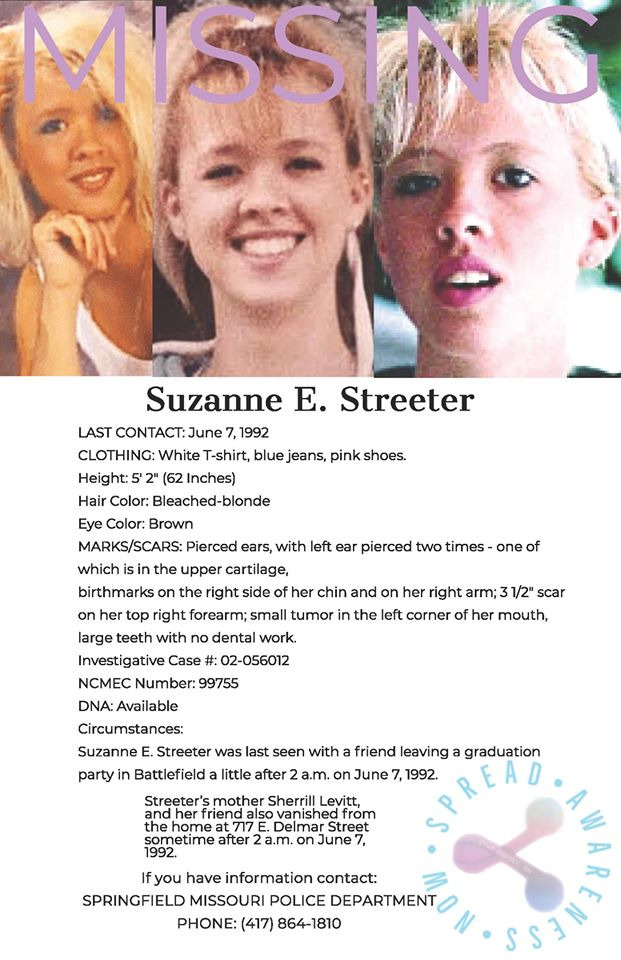
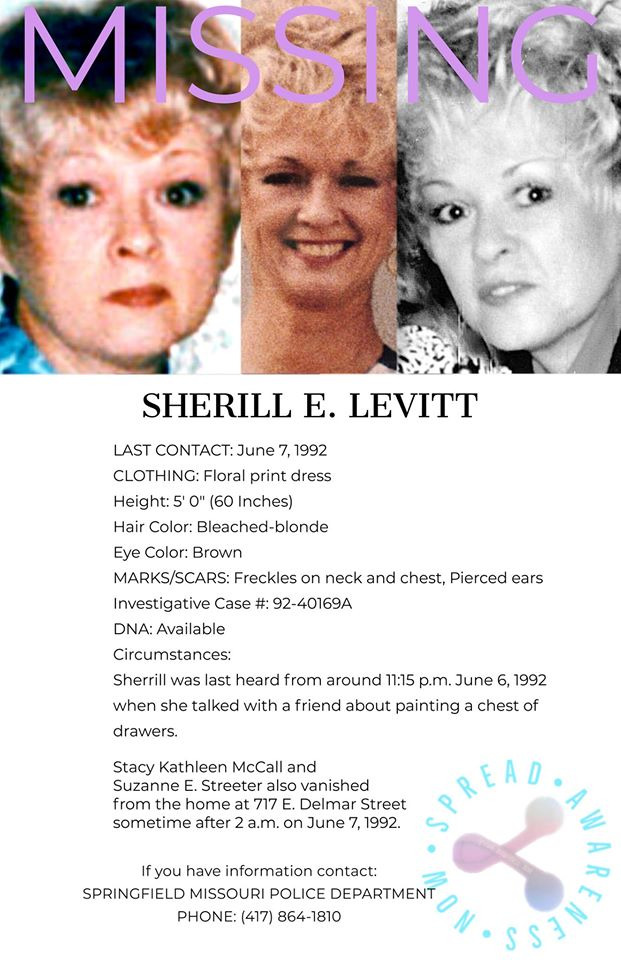
Stacy McCall, 18, Suzanne "Suzie" Streeter, 19, were happy new graduates of Kickapoo High School.Having just graduated on June 6, 1992, Stacy was supposed to be spending the night at Suzie's home at 717 E. Delmar Street.


June 6, 1992, around 8:30 p.m. Stacy had told her mother, Janis McCall, she wanted to go to a party and then head to Branson later that night. Stacy knew her parents were worried about them driving to Branson late at night, so just two hours later, Stacy called to say they weren't going to Branson that night after all. The girls had decided to play it safe, and said she would be staying the night at her friend's house and she would call her mother in the morning. The next morning they’d go to the water park.
Initially, Streeter and McCall planned to stay over at the home of a mutual friend, Janelle Kirby. But when they got there, they discovered that the house was full of people. And in the early hours of the morning, they decided to sleep at Levitt’s home, where both girls would spend the night on Streeter's new waterbed.The girls loaded up and went to another party at friend Michelle Elder's house, but the party on East Hanover street got a little loud, and a neighbor called police. An officer showed up about 1:40 a.m., shooing partiers away.Suzie and Stacy went to their cars parked at Janelle's. Her mom, Kathy Kirby, had a pallet laid out on her living room floor for Suzie and Stacy. Janelle would sleep on the couch because family members from out of town were sleeping in her bedroom.Suzie and Stacy decided they would be more comfortable sleeping on Suzie's new waterbed, and told Janelle they'd see her in the morning.
Kathy Kirby woke up when her daughter came in the front door. She heard the girls outside.
"Follow me to my house," Suzie told her friend.
"OK," Stacy answered. "I will". . .Stacy never did call her mom.Sherrill was last heard from earlier that night around 11:15 p.m. when she talked with a friend about painting a chest of drawers.
Stacy McCall and Suzanne Streeter reportedly left the graduation party in Battlefield together a little after 2 a.m. The girls drove their separate vehicles to the central Springfield home of Streeter's mother, Sherrill Levitt. That's the last known place the three missing women were believed to have been.
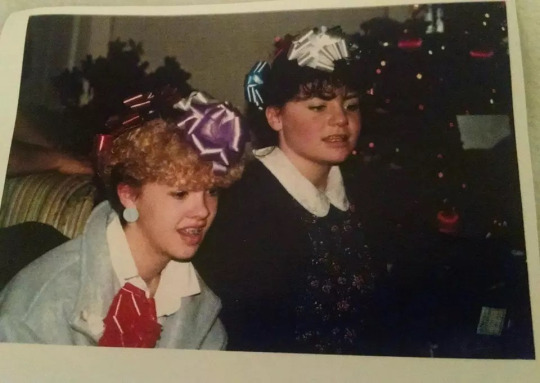
June 7, 1992 friends Janelle Kirby and Mike Hensen, called the home around 8 a.m., there was no answer. Hopping out of her car barefoot, the first thing Janelle noticed was broken glass shimmering on the front steps.
The porch globe was busted, yet the yellow bulb burned bright under the midday sun and no one seemed to be home. Janelle's boyfriend Mike grabbed a broom, swept up the glass and dumped it in the garbage.They later reported that the door was unlocked and all three of the women’s cars were parked out front. Levitt's blue Corsica was parked in the carport. Streeter's red Ford Escort sat in the circle drive with McCall's Toyota Corolla right behind. All of their purses and keys were inside the small white home. The three purses were piled together at the foot of the steps leading into Suzie's bedroom. The purses appeared to be lined up with items were rolling out of them, and Suzie's bed covers were pulled back. First there was Sherrill’s purse, then Suzie’s and Stacy’s was next, sitting on top of Suzie’s overnight bag. Sherrill and Streeter were known to be heavy smokers and their cigarettes were left behind. An undisturbed graduation cake was waiting in the refrigerator.Something happened inside the home between 2:30 a.m. - when police speculate the girls arrived at the Streeter home - and 8 a.m., when a friend of the girls, Janelle Kirby, called to determine what time they would meet to go to the Whitewater theme park in Branson.Something that left Cinnamon the family’s Yorkie distraught. They said they listened to the answering machine to see if there were any messages for them, but instead Janelle and Mike say they received two obscene calls. They left without making a police report and instead went to a friend's house, wondering if Suzie and Stacy had gone there before meeting for the trip to Branson. But their friend Shane hadn't seen the girls. In fact, he was still in bed.
Janelle and Mike returned to 1717 E. Delmar St. one more time. Nothing.
It suddenly occurred to them that the women might have walked to a neighborhood sub shop for lunch, so they hurried over there but again found nothing.Nearly a dozen people came through the home before police were alerted to the scene 10 hours later, including Janis who came to look for her daughter after never receiving a call.It appeared the two girls had made it to the home that night and had gotten ready for bed, as evidenced by the makeup-smeared washcloths in the hamper. Jewelry was left on the wash basin. Inside Suzie’s room — where the TV was left on — Stacy’s flowered shorts were folded and put on top of her sandals. Stacy’s jewelry had been tucked inside the pocket of her shorts. Police believe she left the home wearing only a T-shirt and panties.Levitt’s room, too, showed signs of an unexpected interruption – including a book placed page-down as if to keep its place. Apparently, her bed looked like it had been slept in and her glasses sat abandoned beside it. All of the family’s belongings including cash, in fact, appeared untouched.
How the women left is what baffles police, family and friends.
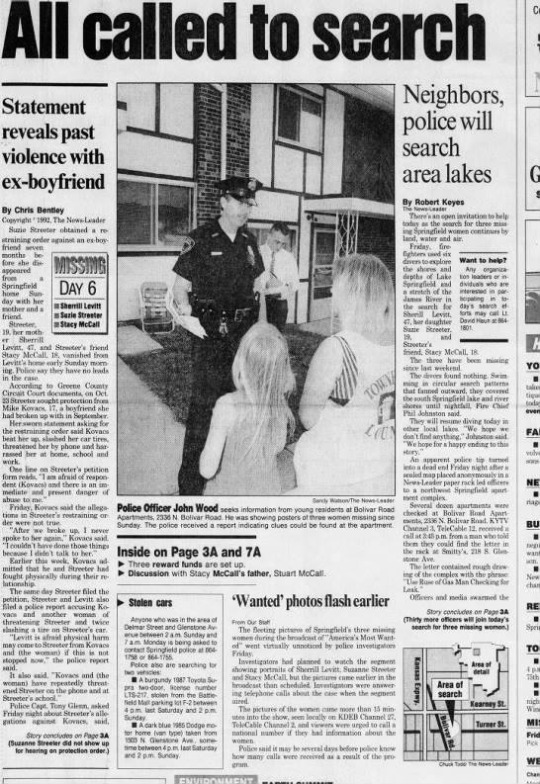
Many have theorized that this crime was the work of more than one person, while authorities say a single man could have used a ruse - something as simple as posing as a utility worker warning of a bogus gas leak in the neighborhood - to lure them out.However on the evening of June 7, Janis knew whatever it was, something was terribly wrong, and she called the police.In the first days, information surfaced about an old Dodge van, a 1964-1970 Dodge panel van, light moss green in color with a white front grill - but investigators still aren’t sure if the van was actually a true clue or a distraction that was never part of the case.
Within a week, divers from the fire department had scoured Lake Springfield, police officers on horseback had searched fields, and more than 20,000 flyers had been distributed across the area.
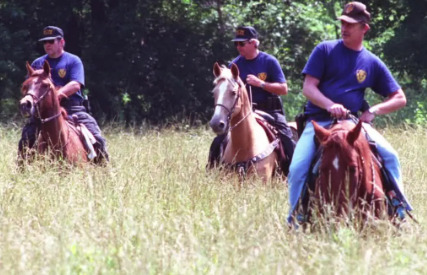
The FBI was called. The faces of Springfield's three missing women were broadcast on the television show "America's Most Wanted."
We did everything we felt was needed to be done. We committed untold resources to this case. -Retired Springfield Police Chief Terry Knowles
Still it turned into one of our states most well-known cold cases.Over the years that have followed many have criticized Terry Knowles, who was the Springfield police chief when the women disappeared, on the grounds he ran the investigation out of his office rather than allowing his detectives to do their jobs.Janis McCall said law enforcement officials didn't always work well together. She recalls weekly conferences on Wednesday afternoons where representatives from Springfield police, the Greene County Sheriff's Office, the highway patrol and more would sit around a table and they didn't check their egos at the door.In fact, early in the investigation the Missouri State Highway Patrol volunteered to bring a "whole truckload of computers" down to help with the investigation, but the Springfield Police Department declined.She said she still believes the organizations haven't shared all their information about the three missing women with each other.Springfield police Sgt. Todd King says that a lot of information was shared in the case's early days. However, at some point, he said, telling the public everything "to a point can hinder an investigation, because when we do look at a potential person of interest or something of that nature, they have just as much information as everyone else on the street." making it more difficult to judge whether or not they're being honest.
Those who followed the case in the 1990s will remember the name Robert Craig Cox, a highly regarded Army Ranger who previously won soldier of the year who was also a convicted kidnapper, robber, and murderer known to be in Springfield when the women went missing. He had worked with Stacy's father at a local car dealership, and in the summer of 1992 he worked as a locator at SM and P Conduit Inc., a Springfield company that locates and marks underground utilities. Cox lied about his alibi on the morning of June 7, 1992, and later proceeded to tell the authorities the three were dead and he knew where they were buried.
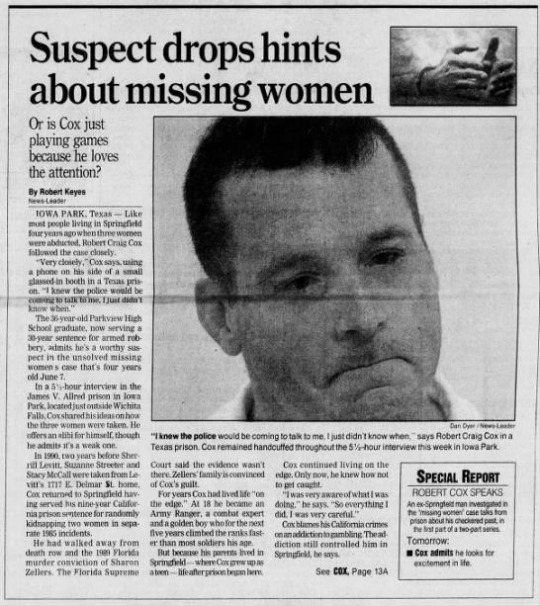
His status hasn't changed in recent years. He remains a person of interest.

Cox was convicted of killing a 19-year-old Florida woman, Dorothy Zellers, who was somehow intercepted while driving home from work at the Walt Disney World Frontierland Trading Post gift shop one night in 1978 and was sentenced to death in that case. Although blood, hair and shoe print evidence was consistent with Cox, the conviction was later overturned. Cox was released and moved from Florida to Springfield to live with his parents.
A composite sketch of an unidentified transient man was released in the days after the disappearances. The individual was allegedly spotted near Sherrill and Suzanne's residence in early June 1992. Authorities do not know if the man was involved in the case. Sherrill's son and Suzanne's older brother, Bartt Streeter, and one of Suzanne's former boyfriends were ruled out as suspects in the case early in the investigation.Another well known theory is that the women are buried underneath a south Springfield parking garage owned by CoxHealth, however police have declined to dig there on the grounds that it is cost prohibitive and they say construction of the parking garage began in September 1993 — some 15 months after the women went missing.
Digging up the area and subsequently reconstructing this structure would be extremely costly, and without any reasonable belief that the bodies could be located here, it is illogical to do so, and for those reasons SPD does not intend to. Investigators have determined this lead to not be credible. -SPD spokeswoman Lisa Cox
Sherrill was employed at New Attitudes Hair Salon on West Sunshine Street in Springfield in 1992. She had 250 clients at the time of her disappearance and was considered a model employee. Her family members describe her as a private person who had a close relationship with Streeter in 1992.
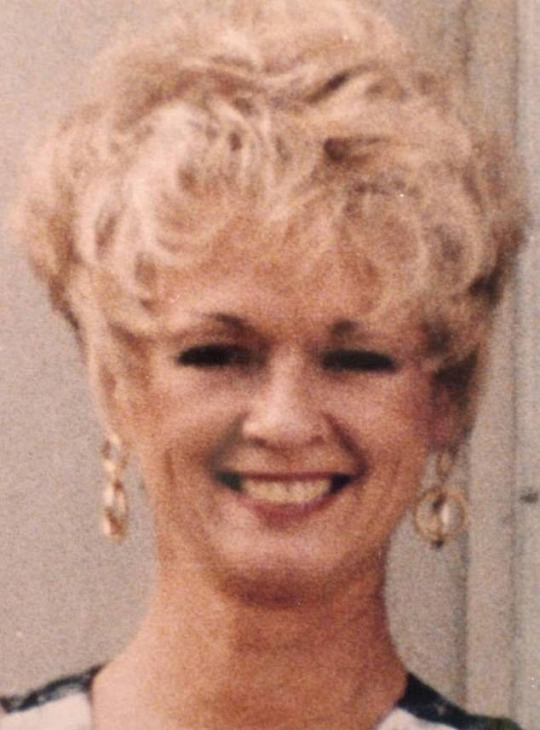
Sherrill Levitt and Suzanne Streeter moved into their home on East Delmar Street in April 1992, two months before their disappearances. Sherrill's 1989 divorce from her second husband, Don Levitt, impacted her finances and she elected to relocate to the smaller residence with her daughter. Don's creditors began asking Sherrill to pay his debts after their divorce. She hired an attorney to locate him without success.
Suzanne was employed at a local movie theater in 1992. She planned to enroll in cosmetology school in the fall of that year. Suzanne had difficulty reading and was placed in classes for students with learning disabilities. A friend speculated that Suzanne may have been dyslexic. She never lived with her father and rarely spoke about him or her stepfather.

Stacy McCall planned to attend Southwest Missouri State University in the fall of 1992. She was employed as a secretary/receptionist at Springfield Gymnastics at the time of her disappearance, and also modeled wedding gowns for The Total Bride in the Brentwood Center. Her family members describe her as conscientious about her appearance. She dated occasionally, but Stacy did not have a boyfriend at the time of her high school graduation.
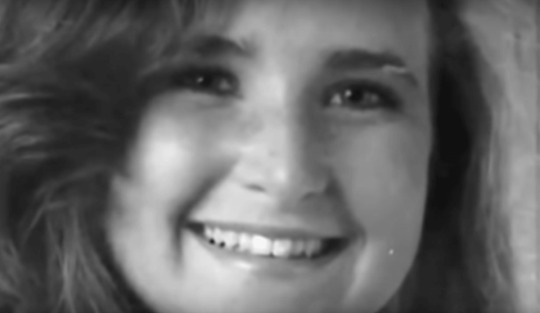
A bench was dedicated to the women in Victims Memorial Garden in Springfield's Phelps Grove Park in 1997.
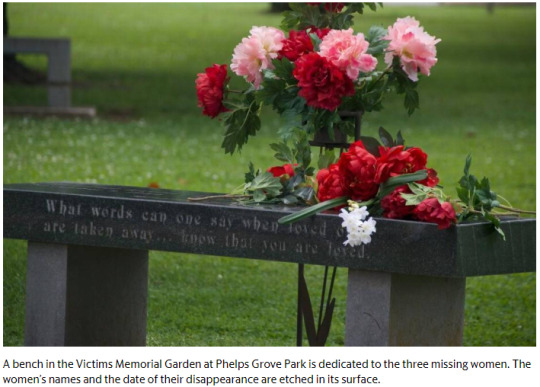
— 1992 —
June 6: 6 p.m. Suzie Streeter and Stacy McCall graduate from Kickapoo High School. Graduation ends at Hammmons Student Center 7:30 p.m. A friend of Suzie's drops off a graduation cake for her. 8:30 p.m. Suzie and Stacy show up at their first party of the night in Battlefield on Coach Drive 9:30 p.m. Sherrill's friend calls her at the house, where she's refinishing a chair 10:30 p.m. Stacy calls home and tells her mom that she won't be driving to Branson. They'll spend the night at Janelle's however the pair wind up at Streeter’s house at 1717 E. Delmar St. about 2 a.m.
June 7.June 7: 1:30 a.m. Suzie and Stacy appear at another party in the 1500 block of East Hanover Street in Springfield Just before 2 a.m. They go back to Janelle's house on their way to Suzie's, where they would sleep in her new king-size waterbed. 8 or 9 a.m. Janelle calls Suzie's house. No answer. She leaves a message. 12:30 p.m. Janelle and her boyfriend go to the house on East Delmar Street looking for Suzie and Stacy, but there is no sign of the girls or Suzie’s mother, Sherrill Levitt. 7 p.m. Janis shows up at the house prepared to take Stacy's belongings and her car home. Police are called late that evening.
June 8: Police begin investigating the case and go to the house and wait for a search warrant to go inside. The unlocked house appears as if the women simply vanished while getting ready for bed. By the end of the night, police know they have something serious on their hands and the media learn about the disappearance.
June 9: The FBI is called in.
June 13: The community is invited to help in the search. Dozens of people comb wooded areas.June 14: Authorities begin a sweep of wooded areas and streams in the Springfield area and search the Bolivar road Apartments after someone leaves a letter in a News-Leader rack at Smitty's 218 S. Glenstone Ave. containing a rough drawing of the apartment complex and the phrase, “use Ruse of Gas Man checking for Leak,”. Also on this day, pictures of the women air on the television show “America's Most Wanted.”
June 15: Police begin working a fresh tip about a transient who neighbors reported seeing near the home in the days before the women disappeared. A sketch is released, showing a man with long hair and a full beard. The Missouri Victim's Center schedules group counseling sessions for friends, family and community members struggling with the disappearance.June 16: Police release a photo of a retouched Dodge van, similar to one seen near Levitt and Streeter's home early on June 7.
June 18: Because of resources needed for the missing women case, the Springfield Police Department eliminates overtime in its traffic and DWI programs.
June 21: Police hammer out their theories. Deputy chief Ron Worsham says it appears to be an Abduction and it could go in two directions. 1. A drifting transient watched and waited, then kidnapped the women. 2. Or the answer was in Levitt's background. Police dig deeper into Levitt's past. The reward fund stands at $3,000.
June 24: Police work on a new tip. A waitress at George’s Steakhouse, one of Levitt’s favorite restaurants, says she saw the three women at the diner between 1 and 3 a.m. June 7. The women arrived and left together. The waitress said Suzie appeared giddy, perhaps intoxicated, and her mom tried to calm her down. The reward fund skyrockets to $40,000 after a secret gift.
June 28: Police end their 24-hour command post at Levitt’s home.July 19: FBI Special Agent James Wright comes to Springfield, to gather information and perhaps develop a psychological profile of the abductor. Sept. 15: Levitt's son, Bartt Streeter, considered an initial suspect, quits his job and leaves Springfield. He has not returned. It is the 100th day of the investigation. Janis McCall: "I'd hate to think of doing this another 100 days."
— 1993 —
Jan. 2: An anonymous New Year’s Eve caller to a switchboard operator of “America's Most Wanted” is cut off when the operator tries to link up with Springfield investigators. Police still seek contact with the man, whom they consider to have prime knowledge of the abductions.
Feb. 14: For the first time, police announce that they are considering the possibility that the disappearances are the work of one or more serial killers.March 9: Suzie Streeter's 20th birthday. Her grandparents offer several hundred dollars in additional reward money in a taped appeal played on local television.April 22: McCall's 19th birthday. Aug. 28: Information from an informant leads police to search farmland in Webster County looking for bodies. Police say they find items at the scene, but will not elaborate. The results of the search warrant were sealed.
— 1994 —
A lead prompts authorities to search a section of Bull Shoals Lake, where they find animal remains and pieces of clothing. The clothing does not match the description of what the women were wearing.
— 1995 —
A grand jury disbands in January without handing up indictments. Robert Craig Cox, whose name came up early in the investigation, is arrested in Texas for aggravated robbery. After information on Cox is presented to a grand jury, investigators interview him in a Texas prison. In the grand jury, Cox’s ex-girlfriend tells jurors that she lied when she told police Cox was with her at church the morning of June 7, 1992.
— 1996 —
Former News-Leader reporter Robert Keyes interviews Cox from prison. The inmate tells Keyes he knows the women were killed and buried somewhere in Springfield or close by. “And they’ll never be found.”
— 1997 —
The family of Sherrill Levitt and Suzie Streeter go through court proceedings to declare the two women dead. Stacy’s parents vow that they will not declare their daughter dead until her body is found.On the fifth anniversary, families of the women dedicate a bench in their honor inside the Victim's Memorial Garden in Phelps Grove Park. Sherrill's father isn't at the dedication - he passed away a few months before.
— 2001 —
Maj. Steve Ijames takes command of the Criminal Investigations Section and reopens several cold cases, including that of the three missing women.
— 2002 —
Springfield police write Cox a letter, requesting an interview. He declines. Also this year, Webster County authorities dig near an abandoned slaughterhouse at a concrete company, south of Marshfield. They find teeth and bone fragments estimated to be about 100 years old.
—2003 —
Following new tips, investigators check an old farm about five miles south of Cassville. Cadaver-seeking dogs show interest in various areas. Tires, trash, a motorcycle and sections of a green vehicle are dug up from the surrounding farmland. DNA samples taken from an abandoned house on the property are sent to a lab for testing, but results were inconclusive.
— 2006 —
A group of amateur detectives go to Springfield police and Greene County Prosecutor Darrell Moore with their theory that the three women are buried under a parking garage near Cox South hospital. Authorities decide not to dig under the garage, saying there isn’t enough evidence to warrant the cost of digging.— 2010 —Paul Williams, Springfield's new police chief, initiates a review of the case, which extends into 2012.— 2012 —Springfield police investigators travel to Virginia and present their review of the case to a panel of 25 criminal-justice investigators assembled by the National Center for Missing and Exploited Children.

LITTLE ELSE IS KNOWN AT THIS TIME.
SHERILL E. LEVITT
: 11-01-44, 5', 110 lbs., brown eyes, short bleached-blonde hair, naturally curly hair, longer on top and short in the back. Sherrill Levitt has a thin build and has freckles on her neck and upper chest area.Clothing:Floral print dressDNA: Available
Agency Case Number: 92-40169A
View Poster
NamUs
#MP345
____________________
STACY K. McCALL
: White female, DOB 04/23/74, 5'3'', 120 lbs., blue eyes, dark blonde hair to the middle of her back with sun-lightened ends. She has freckles on her face and a dimple in the middle of her chin.
Clothing and Accessories:Yellow shirt, flowered bikini panties, brown sandles, 14" herringbone necklace, ring with small diamond, flat gold initial ring.DNA: Available
Agency Case Number: 92-40169C
NCMEC Number: 999751
View Poster
Report a Sighting
NamUs
#MP350
____________________
SUZANNE E. STREETER
: White female, DOB 03/09/73, 5'2'', 102 lbs., brown eyes, straight bleached-blonde, shoulder-length hair, large teeth with no dental work. She has a 3-1/2'' scar on top of her right forearm and a small tumor in the left corner of her mouth, pierced ears with left ear pierced two times.CLOTHING AND ACCESSORIES:White T-shirt, blue jeans, pink shoesDNA: In CODIS
Agency Case Number: 02-056012
NCMEC Number: 999755
View Poster
Report a Sighting
NamUs
#MP3233
______________________If you have any information concerning this person, please contact your
local FBI office
or the nearest
American Embassy or Consulate
.
Submit an anonymous Tip online
or contact
SPRINGFIELD MISSOURI POLICE DEPARTMENT
PHONE:
(417) 864-1810
or
Submit an Anonymous Public Tip
Verify active missing status
here
.See others missing in
Springfield
from your desktop
See other cases: click here on mobile to return to units
See other cases: click here from your desktop to return to Units
Did you know that Spread Awareness Now is available across social media platforms?Be sure to like, follow, and subscribe to us on
Twitter
,
Tumblr
,
Instagram
,
Facebook
, and
YouTube
!____________________________________________
La ducha es un gran lugar para llorar. -Janis McCall
No se supone que las personas simplemente desaparezcan. . .
pero 28 años más tarde, el misterio de lo que le pasó a
Sherrill Elizabeth Levitt
,
Stacy Kathleen McCall
, y
Suzanne E. Streeter
sigue siendo un misterio.Último
mapa de
ubicación conocidoStacy McCall, de 18 años, Suzanne "Suzie" Streeter, de 19 años, eran felices recién graduadas de Kickapoo High School.Recién graduada el 6 de junio de 1992, se suponía que Stacy pasaría la noche en la casa de Suzie en 717 E. Delmar Street.El 6 de junio de 1992, alrededor de las 8:30 pm, Stacy le había dicho a su madre, Janis McCall, que quería ir a una fiesta y luego ir a Branson más tarde esa noche. Stacy sabía que sus padres estaban preocupados de que condujeran a Branson a altas horas de la noche, así que solo dos horas después, Stacy llamó para decir que no iban a Branson esa noche después de todo. Las chicas habían decidido ir a lo seguro y dijeron que pasaría la noche en la casa de su amiga y que llamaría a su madre por la mañana. A la mañana siguiente irían al parque acuático.Inicialmente, Streeter y McCall planearon quedarse en la casa de una amiga común, Janelle Kirby. Pero cuando llegaron allí, descubrieron que la casa estaba llena de gente. Y en las primeras horas de la mañana, decidieron dormir en la casa de Levitt, donde ambas chicas pasarían la noche en la nueva cama de agua de Streeter.Las chicas cargaron y fueron a otra fiesta en la casa de la amiga Michelle Elder, pero la fiesta en la calle East Hanover se hizo un poco ruidosa, y un vecino llamó a la policía. Un oficial apareció alrededor de la 1:40 am, ahuyentando a los fiesteros.Suzie y Stacy fueron a sus autos estacionados en Janelle's. Su madre, Kathy Kirby, tenía una paleta dispuesta en el piso de su sala de estar para Suzie y Stacy. Janelle dormiría en el sofá porque miembros de la familia de fuera de la ciudad estaban durmiendo en su habitación.Suzie y Stacy decidieron que se sentirían más cómodas durmiendo en la nueva cama de agua de Suzie, y le dijeron a Janelle que la verían por la mañana.
Kathy Kirby se despertó cuando su hija entró por la puerta principal. Escuchó a las chicas afuera.
"Sígueme a mi casa", le dijo Suzie a su amiga.
"Está bien", respondió Stacy. "Voy a". . .Stacy nunca llamó a su madre.Sherrill fue escuchado por última vez esa noche, alrededor de las 11:15 pm, cuando habló con un amigo sobre pintar una cómoda.Según los informes,
Stacy McCall
y
Suzanne Streeter
salieron juntas de la fiesta de graduación en Battlefield poco después de las 2 am. Las chicas condujeron sus vehículos separados a la casa central de Springfield de la madre de Streeter,
Sherrill Levitt
. Ese es el último lugar conocido donde se cree que estuvieron las tres mujeres desaparecidas.El 7 de junio de 1992, las amigas Janelle Kirby y Mike Hensen, llamaron a la casa alrededor de las 8 am, no hubo respuesta. Saltando de su auto descalza, lo primero que notó Janelle fue vidrios rotos que brillaban en los escalones delanteros.
El globo del porche estaba roto, pero el bulbo amarillo ardía bajo el sol del mediodía y nadie parecía estar en casa.El novio de Janelle, Mike, agarró una escoba, barrió el vaso y lo tiró a la basura.Más tarde informaron que la puerta estaba abierta y que los tres autos de las mujeres estaban estacionados al frente. La Córcega azul de Levitt estaba estacionada en la cochera. El Ford Escort rojo de Streeter estaba sentado en el círculo con el Toyota Corolla de McCall justo detrás. Todos sus bolsos y llaves estaban dentro de la pequeña casa blanca. Las tres carteras se apilaron al pie de los escalones que conducían a la habitación de Suzie. Las carteras parecían estar alineadas con elementos que se estaban desenrollando, y las sábanas de Suzie fueron retiradas.Primero estaba el bolso de Sherrill, luego el de Suzie y el de Stacy, el siguiente, sentado encima del bolso de noche de Suzie. Se sabía que Sherrill y Streeter eran grandes fumadores y sus cigarrillos fueron dejados atrás.Una tarta de graduación tranquila estaba esperando en el refrigerador.Algo sucedió dentro de la casa entre las 2:30 a.m., cuando la policía especuló que las chicas llegaron a la casa de Streeter, y las 8 a.m., cuando una amiga de las chicas, Janelle Kirby, llamó para determinar a qué hora se reunirían para ir al tema de Whitewater parque en Branson.Algo que dejó a Cinnamon angustiada por la familia de Yorkie.Dijeron que escucharon el contestador automático para ver si había algún mensaje para ellos, pero en cambio Janelle y Mike dicen que recibieron dos llamadas obscenas. Se fueron sin hacer un informe policial y en su lugar fueron a la casa de un amigo, preguntándose si Suzie y Stacy habían ido allí antes de reunirse para el viaje a Branson. Pero su amiga Shane no había visto a las chicas. De hecho, él todavía estaba en la cama.
Janelle y Mike regresaron a 1717 E. Delmar St. una vez más. Nada.
De repente se les ocurrió que las mujeres podrían haber caminado a una tienda secundaria del vecindario para almorzar, por lo que se apresuraron hacia allí pero nuevamente no encontraron nada.Casi una docena de personas llegaron a la casa antes de que la policía fuera alertada a la escena 10 horas después, incluida Janis, que vino a buscar a su hija después de nunca recibir una llamada.Parecía que las dos chicas habían llegado a la casa esa noche y se habían preparado para la cama, como lo demuestran las toallitas manchadas de maquillaje en el cesto. Se dejaron joyas en el lavabo.Dentro de la habitación de Suzie, donde se dejó la televisión encendida, los pantalones cortos con flores de Stacy se doblaron y se pusieron encima de sus sandalias. Las joyas de Stacy habían sido metidas dentro del bolsillo de sus pantalones cortos. La policía cree que ella salió de la casa usando solo una camiseta y bragas.La habitación de Levitt también mostró signos de una interrupción inesperada, incluido un libro colocado en una página hacia abajo como para mantener su lugar. Aparentemente, su cama parecía haber dormido y sus gafas estaban abandonadas a su lado. De hecho, todas las pertenencias de la familia, incluido el efectivo, parecían intactas.Cómo se fueron las mujeres es lo que desconcierta a la policía, la familia y los amigos. Muchos han teorizado que este crimen fue el trabajo de más de una persona, mientras que las autoridades dicen que un solo hombre podría haber usado una artimaña, algo tan simple como hacerse pasar por un trabajador de servicios públicos advirtiendo de una fuga de gas falsa en el vecindario, para atraerlos. .Sin embargo, en la tarde del 7 de junio, Janis sabía lo que fuera, algo estaba terriblemente mal, y llamó a la policía.En los primeros días, surgió información sobre una vieja camioneta Dodge, una camioneta Dodge panel de 1964-1970, de color verde musgo claro con una parrilla delantera blanca, pero los investigadores aún no están seguros de si la camioneta era realmente una pista o una distracción eso nunca fue parte del caso.
En una semana, los buzos del departamento de bomberos recorrieron el lago Springfield, los policías a caballo registraron los campos y se distribuyeron más de 20,000 volantes por toda el área.
Se llamó al FBI. Los rostros de las tres mujeres desaparecidas de Springfield se transmitieron en el programa de televisión "America's Most Wanted".
Hicimos todo lo que sentimos que era necesario hacer. Dedicamos recursos incalculables a este caso. -Jefe jefe de policía de Springfield, Terry Knowles
Aún así, se convirtió en uno de nuestros casos de resfriado más conocidos de nuestro estado.Durante los años que siguieron, muchos criticaron a Terry Knowles, quien era el jefe de policía de Springfield cuando las mujeres desaparecieron, alegando que dirigió la investigación fuera de su oficina en lugar de permitir que sus detectives hicieran su trabajo.Janis McCall dijo que los funcionarios encargados de hacer cumplir la ley no siempre trabajaban bien juntos. Ella recuerda conferencias semanales los miércoles por la tarde donde representantes de la policía de Springfield, la Oficina del Sheriff del Condado de Greene, la patrulla de carreteras y más se sentaban alrededor de una mesa y no revisaban sus egos en la puerta.De hecho, al principio de la investigación, la Patrulla de Carreteras del Estado de Missouri se ofreció como voluntario para llevar una "carga completa de computadoras" para ayudar con la investigación, pero el Departamento de Policía de Springfield se negó.Dijo que todavía cree que las organizaciones no han compartido toda su información sobre las tres mujeres desaparecidas entre sí.El sargento de policía de Springfield. Todd King dice que se compartió mucha información en los primeros días del caso. Sin embargo, en algún momento, dijo, decirle al público todo "hasta cierto punto puede dificultar una investigación, porque cuando miramos a una persona potencial de interés o algo de esa naturaleza, tienen tanta información como todos los demás en el calle." haciendo que sea más difícil juzgar si están siendo honestos o no.
Aquellos que siguieron el caso en la década de 1990 recordarán el nombre de Robert Craig Cox,
un Ranger del Ejército de gran prestigio que anteriormente ganó el soldado del año y que también fue
un secuestrador, ladrón y asesino convicto que se sabía que estaba en Springfield cuando las mujeres desaparecieron. H
e había trabajado con el padre de Stacy en un concesionario de automóviles local, y en el verano de 1992 trabajó como localizador en SM y P Conduit Inc., una compañía de Springfield que localiza y marcas de servicios públicos subterráneos. Cox mintió sobre su coartada en la mañana del 7 de junio de 1992, y luego
procedió a decirle a las autoridades que los tres estaban muertos y que sabía dónde estaban enterrados. Su estado no ha cambiado en los últimos años. Sigue siendo una persona de interés.
Cox fue condenado por matar a una mujer de Florida de 19 años, Dorothy Zellers, quien fue interceptada de alguna manera mientras conducía a casa desde el trabajo en la tienda de regalos Walt Disney World Frontierland Trading Post una noche en 1978 y fue sentenciada a muerte en ese caso. Aunque la evidencia de huellas de sangre, cabello y zapatos era consistente con Cox, la condena fue revocada más tarde. Cox fue liberado y se mudó de Florida a Springfield para vivir con sus padres.Un boceto compuesto de un hombre transitorio no identificado fue publicado en los días posteriores a las desapariciones. Al parecer, el individuo fue visto cerca de la residencia de Sherrill y Suzanne a principios de junio de 1992. Las autoridades no saben si el hombre estuvo involucrado en el caso. El hijo de Sherrill y el hermano mayor de Suzanne, Bartt Streeter, y uno de los ex novios de Suzanne fueron descartados como sospechosos en el caso al principio de la investigación.Otra teoría bien conocida es que las mujeres están enterradas debajo de un estacionamiento en el sur de Springfield propiedad de CoxHealth, sin embargo, la policía se negó a excavar allí por el costo prohibitivo y dicen que la construcción del estacionamiento comenzó en septiembre de 1993, unos 15 meses después de que las mujeres desaparecieron.
Desenterrar el área y posteriormente reconstruir esta estructura sería extremadamente costoso, y sin ninguna creencia razonable de que los cuerpos podrían estar ubicados aquí, es ilógico hacerlo, y por esas razones SPD no tiene la intención de hacerlo. Los investigadores han determinado que esta ventaja no es creíble. -SPD portavoz Lisa Cox
Sherrill trabajaba en New Attitudes Hair Salon en West Sunshine Street en Springfield en 1992. Tenía 250 clientes en el momento de su desaparición y fue considerada una empleada modelo. Los miembros de su familia la describen como una persona privada que tuvo una relación cercana con Streeter en 1992.
Sherrill Levitt
y
Suzanne Streeter se
mudaron a su casa en East Delmar Street en abril de 1992, dos meses antes de su desaparición. El divorcio de Sherrill en 1989 de su segundo esposo, Don Levitt, afectó sus finanzas y ella decidió mudarse a la residencia más pequeña con su hija. Los acreedores de Don comenzaron a pedirle a Sherrill que pagara sus deudas después de su divorcio. Ella contrató a un abogado para localizarlo sin éxito.Suzanne trabajaba en una sala de cine local en 1992. Planeaba inscribirse en la escuela de cosmetología en el otoño de ese año. Suzanne tuvo dificultades para leer y fue asignada a clases para estudiantes con discapacidades de aprendizaje. Un amigo especuló que Suzanne podría haber sido disléxica. Ella nunca vivió con su padre y rara vez hablaba de él o su padrastro.
Stacy McCall
planeaba asistir a la Southwest Missouri State University en el otoño de 1992. Fue empleada como secretaria / recepcionista en Springfield Gymnastics en el momento de su desaparición, y también modeló vestidos de novia para The Total Bride en el Centro Brentwood. Los miembros de su familia la describen como consciente de su apariencia. Salía ocasionalmente, pero Stacy no tenía novio cuando se graduó de la escuela secundaria.Un banco fue dedicado a las mujeres en Victims Memorial Garden en Phelps Grove Park en Springfield en 1997.- 1992 -
6 de junio: 6 pm Suzie Streeter y Stacy McCall se gradúan de Kickapoo High School. La graduación termina en el Hammmons Student Center a las 7:30 pm. Una amiga de Suzie le deja un pastel de graduación. 8:30 pm Suzie y Stacy aparecen en su primera fiesta de la noche en Battlefield en Coach Drive. 9:30 pm La amiga de Sherrill la llama a la casa, donde está arreglando una silla. 10:30 pm Stacy llama a casa y le dice a su madre que ella no conducirá a Branson. Pasarán la noche en casa de Janelle, sin embargo, la pareja termina en la casa de Streeter en 1717 E. Delmar St. alrededor de las 2 am del 7 de junio.7 de junio: 1:30 a.m. cama de agua. 8 o 9 am Janelle llama a la casa de Suzie. Sin respuesta. Ella deja un mensaje. 12:30 pm Janelle y su novio van a la casa en East Delmar Street buscando a Suzie y Stacy, pero no hay señales de las niñas o la madre de Suzie, Sherrill Levitt. 7 pm Janis aparece en la casa preparada para llevar las pertenencias de Stacy y su auto a casa. Se llama a la policía tarde esa noche.8 de junio: la policía comienza a investigar el caso, va a la casa y espera a que ingrese una orden de allanamiento. La casa abierta parece como si las mujeres simplemente desaparecieran mientras se preparaban para la cama. Al final de la noche, la policía sabe que tienen algo serio en sus manos y los medios se enteran de la desaparición.9 de junio: se llama al FBI.13 de junio: Se invita a la comunidad a ayudar en la búsqueda. Decenas de personas peinan áreas boscosas.14 de junio: Las autoridades comienzan a barrer áreas boscosas y arroyos en el área de Springfield y buscan en los apartamentos de Bolivar Road luego de que alguien deja una carta en un estante de News-Leader en Smitty's 218 S. Glenstone Ave. que contiene un dibujo aproximado del complejo de apartamentos y la frase, "use Ruse of Gas Man buscando fugas". También en este día, las imágenes de las mujeres se transmiten en el programa de televisión "America's Most Wanted".15 de junio: la policía comienza a trabajar en una nueva información sobre un transeúnte que los vecinos informaron haber visto cerca de la casa en los días previos a la desaparición de las mujeres. Se lanza un boceto que muestra a un hombre con cabello largo y barba completa. El Centro de Víctimas de Missouri programa sesiones de asesoramiento grupal para amigos, familiares y miembros de la comunidad que luchan con la desaparición.16 de junio: la policía publica una foto de una camioneta Dodge retocada, similar a una vista cerca de la casa de Levitt y Streeter a principios del 7 de junio.18 de junio: Debido a los recursos necesarios para el caso de mujeres desaparecidas, el Departamento de Policía de Springfield elimina las horas extra en sus programas de tráfico y DWI.21 de junio: la policía desarrolla sus teorías. El subdirector Ron Worsham dice que parece ser un secuestro y que podría ir en dos direcciones. 1. Un transitorio a la deriva observó y esperó, luego secuestró a las mujeres. 2. O la respuesta estaba en los antecedentes de Levitt. La policía profundiza en el pasado de Levitt. El fondo de recompensa asciende a $ 3,000.24 de junio: la policía trabaja en una nueva propina. Una camarera en George's Steakhouse, uno de los restaurantes favoritos de Levitt, dice que vio a las tres mujeres en el restaurante entre la 1 y las 3 de la mañana del 7 de junio. Las mujeres llegaron y se fueron juntas. La camarera dijo que Suzie parecía mareada, tal vez intoxicada, y su madre trató de calmarla. El fondo de recompensa se dispara a $ 40,000 después de un regalo secreto.28 de junio: la policía termina su puesto de comando de 24 horas en la casa de Levitt.19 de julio: el agente especial del FBI James Wright llega a Springfield para recopilar información y tal vez desarrollar un perfil psicológico del secuestrador.15 de septiembre: el hijo de Levitt, Bartt Streeter, considerado un sospechoso inicial, deja su trabajo y deja Springfield. El no ha regresado. Es el centésimo día de la investigación. Janis McCall: "Odiaría pensar en hacer esto otros 100 días".- 1993 -
2 de enero: una llamada anónima de Nochevieja a un operador de centralita telefónica de "America's Most Wanted" se interrumpe cuando el operador intenta conectarse con los investigadores de Springfield. La policía aún busca contacto con el hombre, a quien consideran que tiene un conocimiento primordial de los secuestros.
14 de febrero: por primera vez, la policía anuncia que están considerando la posibilidad de que las desapariciones sean obra de uno o más asesinos en serie.9 de marzo: 20 cumpleaños de Suzie Streeter. Sus abuelos ofrecen varios cientos de dólares en recompensas adicionales en un recurso grabado en la televisión local.22 de abril: 19 cumpleaños de McCall.28 de agosto: la información de un informante lleva a la policía a buscar tierras de cultivo en el condado de Webster en busca de cuerpos. La policía dice que encuentran elementos en la escena, pero no darán más detalles. Los resultados de la orden de allanamiento fueron sellados.
- 1994 -
Un líder lleva a las autoridades a buscar en una sección del lago Bull Shoals, donde encuentran restos de animales y prendas de vestir. La ropa no coincide con la descripción de lo que llevaban las mujeres.
- 1995 -
Un gran jurado se disuelve en enero sin presentar acusaciones. Robert Craig Cox, cuyo nombre apareció al principio de la investigación, es arrestado en Texas por robo con agravantes. Después de que la información sobre Cox se presenta a un gran jurado, los investigadores lo entrevistan en una prisión de Texas. En el gran jurado, la ex novia de Cox le dice al jurado que mintió cuando le dijo a la policía que Cox estaba con ella en la iglesia la mañana del 7 de junio de 1992.
- 1996 -
El ex reportero de News-Leader Robert Keyes entrevista a Cox desde la prisión. El recluso le dice a Keyes que sabe que las mujeres fueron asesinadas y enterradas en algún lugar de Springfield o cerca. "Y nunca los encontrarán".
- 1997 -
La familia de Sherrill Levitt y Suzie Streeter pasan por los procedimientos judiciales para declarar a las dos mujeres muertas. Los padres de Stacy prometen que no declararán a su hija muerta hasta que se encuentre su cuerpo. En el quinto aniversario, las familias de las mujeres dedican un banco en su honor dentro del Victim's Memorial Garden en Phelps Grove Park. El padre de Sherrill no está en la dedicación: falleció unos meses antes.- 2001 - El
mayor Steve Ijames toma el mando de la Sección de Investigaciones Criminales y reabre varios casos sin resolver, incluido el de las tres mujeres desaparecidas.
- 2002 -
La policía de Springfield le escribe a Cox una carta solicitando una entrevista. El declina. También este año, las autoridades del condado de Webster cavan cerca de un matadero abandonado en una compañía de concreto, al sur de Marshfield. Encuentran dientes y fragmentos óseos que se estima tienen unos 100 años.—2003 -
Siguiendo nuevos consejos, los investigadores revisan una antigua granja a unas cinco millas al sur de Cassville. Los perros que buscan cadáveres muestran interés en varias áreas. Neumáticos, basura, una motocicleta y secciones de un vehículo verde se excavan de las tierras de cultivo circundantes. Las muestras de ADN tomadas de una casa abandonada en la propiedad se envían a un laboratorio para su análisis, pero los resultados no fueron concluyentes.
- 2006 -
Un grupo de detectives aficionados van a la policía de Springfield y al fiscal del condado de Greene, Darrell Moore, con su teoría de que las tres mujeres están enterradas debajo de un estacionamiento cerca del hospital Cox South. Las autoridades deciden no excavar debajo del garaje, diciendo que no hay evidencia suficiente para justificar el costo de excavar.- 2010 -Paul Williams, el nuevo jefe de policía de Springfield, inicia una revisión del caso, que se extiende hasta 2012.- 2012 -Los investigadores de la policía de Springfield viajan a Virginia y presentan su revisión del caso a un panel de 25 investigadores de justicia penal reunidos por el Centro Nacional para Niños Desaparecidos y Explotados.POCO MÁS SE CONOCE EN ESTE MOMENTO.
SHERILL E. LEVITT
: 11-01-44, 5 ', 110 lbs., Ojos marrones, cabello corto rubio decolorado, cabello naturalmente rizado, más largo en la parte superior y corto en la parte posterior. Sherrill Levitt tiene una constitución delgada y tiene pecas en el cuello y la parte superior del pecho.Ropa:Vestido estampado floralADN : Número de caso de agencia disponible
: 92-40169A
Ver póster
NamUs
# MP345
____________________
STACY K. McCALL
: Hembra blanca, fecha de nacimiento 23/04/74, 5'3 '', 120 lbs., Ojos azules, cabello rubio oscuro en la mitad de la espalda con extremos iluminados por el sol. Ella tiene pecas en la cara y un hoyuelo en el medio de la barbilla.
Ropa y accesorios:Camisa amarilla, bragas de bikini con flores, sandles marrones, collar de espiga de 14 ", anillo con pequeño diamante, anillo inicial de oro plano.ADN :
Número de caso de agencia
disponible : 92-40169C Número de NCMEC: 999751
Ver póster
Informar sobre una observación
NamUs
# MP350
____________________
SUZANNE E. STREETER
: Hembra blanca, fecha de nacimiento 03/09/73, 5'2 '', 102 lbs., Ojos marrones, rubio liso, cabello largo hasta los hombros, dientes grandes sin trabajo dental. Ella tiene una cicatriz de 3-1 / 2 '' en la parte superior de su antebrazo derecho y un pequeño tumor en la esquina izquierda de su boca, orejas perforadas con la oreja izquierda perforada dos veces.ROPA Y ACCESORIOS:Camiseta blanca, tejanos, zapatos rosasADN : En la
Agencia
CODIS Número de caso: 02-056012 Número NCMEC: 999755
Ver póster
Informar un avistamiento
NamUs
# MP3233
______________________Si tiene alguna información sobre esta persona, comuníquese con su
oficina local del FBI
o la
embajada o consulado estadounidense
más cercano .
Enviar un consejo anónimo en línea
o comuníquese con el TELÉFONO
DEL
DEPARTAMENTO DE POLICÍA DE SPRINGFIELD MISSOURI
:
(417) 864-1810
o
envíe
una sugerencia pública anónima
Verifique el estado faltante activo
aquí
.Ver otros desaparecidos en
Springfield
desde su escritorio
1 note
·
View note
Text
People, April 20
If you watched or plan to watch Tiger King, please read this and make a donation to WWF to help save captive tigers:
https://www.worldwildlife.org/stories/5-things-tiger-king-doesn-t-explain-about-captive-tigers
Cover: The Untold Story of Tiger King

Page 1: Chatter -- Jada Pinkett Smith, Millie Bobby Brown, Adam Levine, Andy Cohen, Sarah Hyland, Matt LeBlanc
Page 2: 5 Things We’re Talking About Right Now -- SVU’s Stabler fights again, Ina Garten supersizes her cosmo, Ariana Grande shows off her quarantine hair, kids can get a Hogwarts education
Page 4: Contents

Page 7: Editor’s Letter -- what we’ll remember about the age of coronavirus
Page 8: StarTracks -- Cuddly Companions -- Tyler Cameron on a run with his dog Harley
Page 9: Masked Hugh Jackman and wife Deborra-Lee Furness in NYC with their dogs Dali and Allegra, Yolanda Halid with goats on her farm, Kate Beckinsale and her cat Willow, Demi Moore and her dog Cowboy, Henry Golding and wife Liv Lo out in LA walking their new foster dog Stella
Page 10: Stars Working From Home -- John Krasinski, Jimmy Kimmel and his kids Jane and Billy, Gayle King, Robin Roberts and her dog Lukas, Jimmy Fallon
Page 11: Chris Hemsworth and wife Elsa Pataky out in Byron Bay, Arnold Schwarzenegger on a bike ride with son Patrick Schwarzenegger, Jonah Hill on a skateboard
Page 12: Queen Elizabeth spoke to Britain and Commonwealth countries about the coronavirus outbreak, Gabrielle Union and daughter Kaavia rocking their natural curls, Thomas Rhett celebrated his 30th birthday with daughters Willa and Ada, Christine Quinn of Selling Sunset married Christian Richard in a secret Gothic winter-wonderland-themed ceremony
Page 15: There’s nothing like a lockdown to test a relationship and Lady Gaga and Michael Polansky have been passing with flying colors -- the pair are spending quality time at her Malibu house
Page 16: Other famous couples getting closer too -- Chris Martin and Dakota Johnson, Shawn Mendes and Camila Cabello, Irina Shayk and Vito Schnabel, Ben Affleck and Ana de Armas, Katy Perry and Orlando Bloom are expecting a baby girl
Page 18: Selena Gomez reveals she has bipolar disorder
Page 22: Heart Monitor -- John Mellencamp and Jamie Sue “Nurse Jamie” Sherrill new couple, Jay-Z and Beyonce happy anniversary, Taraji P. Henson and Kelvin Hayden wedding on hold, Jessie J and Channing Tatum split again
Page 24: RHOBH Teddi Mellencamp Arroyave on life with a newborn
Page 27: Prince Harry and Meghan Markle’s royal highs and lows
Page 28: Passages, Tribute Honor Blackman
Page 29: Tribute Bill Withers
Page 31: Stories to Make You Smile -- two shelter puppies enjoy the run of the Georgia Aquarium and find a forever home
Page 33: People Picks -- Mrs. America

Page 34: Belgravia, Celebrity IOU, Q&A Justin Hires
Page 36: Run, Insecure, Quibi
Page 37: Books
Page 38: Cover Story -- Tiger King
Page 45: Kennedy family mourns again as RFK granddaughter Maeve Kennedy McKean and her son Gideon die in a boating accident
Page 46: A Devastating Week -- those lost to Covid-19
Page 49: Coronavirus -- what to know now
Page 50: Justin Timberlake and Anna Kendrick -- kids asked, they answered
Page 52: House of Horror Kids Update -- taking back their lives -- two years after the Turpin siblings escaped hellish abuse and torture they are finding new futures and friends and families
Page 54: Sean Hayes -- it helps to laugh -- as he gets ready to say goodbye to Will & Grace again he talks about love, life in lockdown and what’s next
Page 57: From Foster Kid to Mother of Eight -- after an abusive and lonely childhood Jessica Benzakein is giving her kids the home she never had
Page 60: Zach and Tori Roloff -- we were built for this family life -- the TLC stars open up about how raising kids has given them purpose
Page 65: General Hospital star Maurice Benard saved by love and lithium -- for years the soap star tried to tough out his bipolar disorder but now marking his 27th year in treatment he’s sharing his journey
Page 68: The AIDS quilt marches home -- how one woman’s tribute to her friends jump-started the largest piece of folk art in the world and is a reminder of how powerful care and compassion can be
Page 73: Marie Kondo -- The Way I Live Now -- the queen of decluttering shares tips on working joyfully from home and admits she isn’t always Happy Marie
Page 77: Christina Anstead -- what my life’s really like
Page 79: 7 Self-Care Tips to Reduce Stress -- Mindy Kaling
Page 81: January Jones
Page 87: Second Look -- Fran Drescher and Renee Taylor and Charles Shaughnessy of The Nanny
Page 88: One Last Thing -- Angela Kinsey
#tabloid#tabloid toc#tiger king#lady gaga#covidー19#justin timberlake#marie kondo#Selena Gomez#mrs. america#coronavirus#Anna Kendrick#turpin family#sean hayes#maurice benard#christina anstead#angela kinsey#zach roloff
0 notes